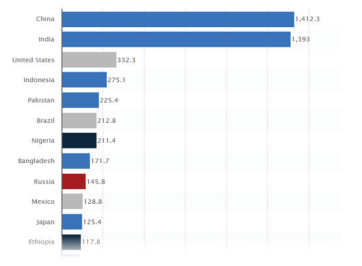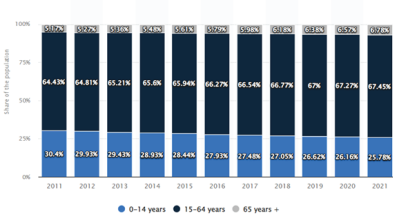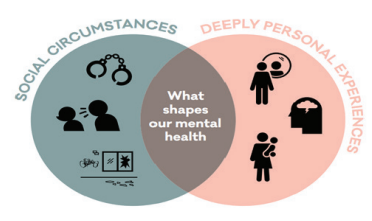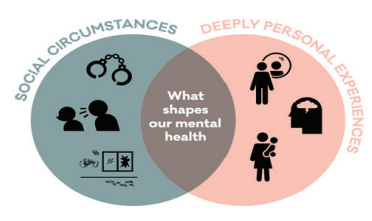Abstract
In this technological era genome technology is progressing rapidly and there has been a growth in the interest of social genomics pertaining to the amount genetics are involved in forming and resulting in social relationships. This study aims to understand the role of struggling youths in Indian Society. There is an objective to facilitate the hardships of youth towards societal integration and improved quality of life. A systematic review of literature has been utilised in this study to understand differing social factors affecting genome activity in youths in India. Results have indicated that the youths in India face challenges pertaining to education, mental health including stress and depression, employment, corruption, peer pressure linked to drug, alcohol and substance abuse. Within this study there is a focus on mental health, education, and environment. Results have revealed that genetics do influence attainment levels directly via social mobility and through domestic family environments. An individual’s genetics does not solely or directly affect educational attainment levels; however it influences the development of behaviours and traits which result in the success of educational endeavours. Recommendations are made to facilitate the hardships of youth towards societal integration and improved quality of life. The production of new research can provide future opportunities to unravel the genomic factors that influence outcomes for challenges faced by the youth in India.
Introduction
In recent years there has been a growth in the interest of social genomics pertaining to the amount that genetics are involved in the formation and outcome of social relationships (Domingue & Belsky, The social genome: Current findings and implications for the study of human genetics, 2017). India is the second most populous country in the world after China, with a population of approximately 1.4 billion inhabitants. Figure 1 illustrates twenty countries with the largest population in the middle of 2021 in millions (O’Neill, Twenty countries with the largest population in mid 2021, 2022). Youth are the future of a nation, and through their actions they contribute towards the future. Figure 2 illustrates the age distribution in India between 2011 and 2021. Approximately 25.78% of the population are aged between zero to fourteen. 67.45% of the overall population are aged between fifteen to sixty-four years. 6.78% of the population are over the age of sixty-five (O’Neill, 2022).

The World Health Organization defines adolescents as individuals who are between the ages of ten to nineteen, while youth or young people are between the ages of ten and twenty-four (WHO, 2022). During this period in their lives, adolescence undergo a period of critical development within which behavioural patterns are formed and the individual’s overall mental health is established. It further evolves into adulthood and affected by socioeconomic attainment (Crosnoe, Mistry, & Elder, 2002). In addition, during youthhood individuals form peer networks through which they are influenced and can influence others (Maxwell, 2002).
Objective
This study aims to understand the role of struggling youths in India Society. There is an objective to facilitate the hardships of youth towards societal integration and improved quality of life. A systematic review of literature has been utilised in this study.

Results and Discussion
Results have indicated that the youths in India face challenges pertaining to education, mental health including stress and depression, employment, corruption, peer pressure linked to drug, alcohol and substance abuse. Within this study there is a focus on mental health, education, and the environment.
Mental health
Negative mental health challenges have become heightened within contemporary life. It has been more evident through the coronavirus (covid-19) pandemic as individuals reported heightened mental health challenges. There was a rise in anxiety, depression, and loneliness (Somani, The Impact of COVID-19 on Human Psychology, 2020) that need to be resolved prior to reaching a global health crisis. With technological advancements in psychiatry, underlying genetic syndromes can be detected via genetic testing. It can be used to diagnose and treat disorders like “autism spectrum disorder, attention deficit and hyperactivity disorder, schizophrenia, and bipolar disorder” (Pinzón-Espinosa, van der Horst, & Zinkstok, 2022). Although some mental health challenges can be influenced by genetics, genes contribute little to shape individual health when compared to social circumstances. Thus, the youth in India need to focus on the diverse social, economic, and emotional factors that they are subjected to, which are believed to interact with human biology and genes. This is because these factors combined with family relationships, can lead to individuals towards developing mental health challenges like anxiety, depression, obsessive compulsive disorder, in addition to psychosis and bipolar disorder, which are more severe mental health challenges. Figure 3 illustrates that mental health is shaped by deep personal experiences that define an individua, while social circumstances are circumstances that individuals encounter (Kousoulis, 2019). For example, individuals residing in poverty situations, unemployment, violence etc.

Education
All individuals have a right to education, however within India numerous inequalities persist in education acquisition. This can be due to financial implications of attending educational institutions, socio-economic inequalities, gender inequalities or family responsibilities (Somani, 2021). “Educational attainment is taken by social genomics as a key socioeconomic outcome that is related to other outcomes such as occupation, social status, wealth, and health” (Williamson, 2022). The genome is fixed at conception therefore it is environmental circumstances that have an impact upon an individual’s educational outcomes. In contrast, research also suggests that the individual’s genetic variation is dependent upon environmental impacts. Thus, genetics and environment can be attributed towards shaping the outcome of an individual. Approximately ten to thirty percent of youths face challenges resulting from behaviours that impact their health. This can only be overcome through sufficient education, adaptation of policies and healthcare professionals. Youths in India can face nutritional disorders including malnutrition and over nutrition. Other health risks include the use of excessive alcohol, tobacco, and substance abuse. In addition, high risk sexual behaviours and injuries which can result in violence, suicide, and accidents. These impacts can have detrimental consequences for the youths of India. Poor health can arise from the existence of several behaviours and conditions together. This can lead to the initiation of noncommunicable diseases like mental health challenges constituting towards a rise in disabilities, morbidity, mortality, and an increase in socio-economic losses impacting Indian economy. Poor sanitation and insufficient funding to help with challenges lead to a rise in communicable diseases and discrimination. Therefore, in order to break this cycle, all youth need to be educated so that well informed decisions can be made for the future of the nation and overcome economical challenges.
Environment
Research suggests that when youth spend time with their friends within social settings, they have correlated genotypes. Educational assignments are a primary reason for similarities within the genetics between colleagues. Within the educational situation it is believed that social genetic effects impact educational attainment levels. However, in contrast, when the height of individuals was tested there was no association between height genetics and friends (Domingue, Belsky, Fletcher, & Harris, 2018). It is important to have genetic similarities between friends because:
- The social networks that individuals cultivate influence who they mate with
- Social genetic effects are perceived to alter the genotype of one’s ego phenotype (Rauscher, Conley, & Siegal, 2015).
Due to this, social genomics could have undesired consequences in a population pertaining to the distribution of phenotypes on the future populations, A contributing factor is due to the people that individuals choose to mate with. Research has identified that the risk of obesity and educational attainment levels are influenced by the genetics of an individual’s social network (Baud, 2017). Social class and genetics could be perceived as a fundamental element of life’s outcomes, due to the fact they exist from the outset of human development. They are linked with numerous important outcomes in the life of an individual, and they influence cultures over time (Polderman, 2015). Therefore, it is not surprising that genetics influence social class and education (Branigan, McCallum, & Freese, 2013).
When spousal genotypes have been investigated, research has suggested that a married or co-habiting couple share more genetic similarities when compared to random pairs within the population (Domingue, Fletcher, Conley, & Boardman, 2014). In addition to married couples, long standing friendships that are still present within adult hood are more genetically similar in comparison (Christakis & Fowler, 2014). When a couple has a child, it was found that individuals “with more education- linked genetics were more successful in comparison to their parents and siblings”. However, a mother’s education-linked genetics can predict what their child’s attainment levels would be. Thus, research has found that there is an environmentally mediated genetic effect on youths.
Conclusion
The youth face numerous struggles within Indian society today, particularly because of the covid-19 pandemic. The primary challenges that youth face include education, mental health including stress and depression, employment, corruption, body image, peer pressure linked to drug, alcohol and substance abuse. Social genomics can be linked to specific phenotypes that are influenced by education, social environment, and obesity (Tropf, 2017). In contrast evidence fails to suggest that height is influenced by struggles faced in Indian society. Instead, it has been found that genetics do influence attainment levels directly via social mobility and through family environments. In addition, genetics do have an influence on social class and education, although the nature of this influence requires more research.
An individual’s genetics does not solely or directly affect educational attainment levels; however, it influences the development of behaviours and traits which result in the success of educational endeavours. To facilitate the hardships of youth towards societal integration and improved quality of life, education is vital. All youth should have access to quality education despite their background. Governmental and non-governmental organisations should work together to ensure skill development courses are available for all youth. Adequate support systems should be implemented to support the challenges faced by the youths in Indian societies bespoke to their cultures and traditions with equal opportunities to succeed. In addition, with mental health challenges rising, psychiatric genetic counselling services should be made available with cultural appropriation and the necessary funding available. The array of genomic data available within studies is growing. Hence the production of new research can provide future opportunities to unravel genomic factors that influence the outcomes for challenges faced by the youth in India. There should be an opportunity to implement mechanisms for intervention to help improve the quality of live of youths in India through research findings on social genomics.
DOI
https://doi.org/10.57259/GRJ6284
Research Objectives:
To understand the role of struggling youths in India Society. There is an objective to facilitate the hardships of youth towards societal integration and improved quality of life.
Bio

Lakhmi Chand is the director of BMD FOUNDATION, India. He is a social Activist, Strong Analytical, Educator, Motivational speaker and Multi-National Award Winner. He works for the betterment of society in villages of the district aiding Community Mobilization and Counselling. He helps global societies in Education, Women Empowerment, Youth Development with the aim of building and working together with rural women SHGs with the help of NGOs. He has attended a number of State and National level Seminars, Workshops and Conferences. Lakhmi Chand has also worked in the field of Environmental protection, water conservation and Rural and Social Development. During COVID-19, he has provided rationing to families that live in the slums helped people in need within society. He has done this by distributing more than 3000 rationing kits and more than 10000 masks.

